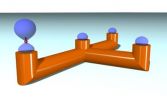(Press-News.org) PITTSBURGH—Smartphones, GoPro cameras and Google Glass are making it easy for anyone to shoot video anywhere. But, they do not make it any easier to watch the tedious videos that can result. Carnegie Mellon University computer scientists, however, have invented a video highlighting technique that can automatically pick out the good parts.
Called LiveLight, this method constantly evaluates action in the video, looking for visual novelty and ignoring repetitive or eventless sequences, to create a summary that enables a viewer to get the gist of what happened. What it produces is a miniature video trailer. Although not yet comparable to a professionally edited video, it can help people quickly review a long video of an event, a security camera feed, or video from a police cruiser's windshield camera.
A particularly cool application is using LiveLight to automatically digest videos from, say, GoPro or Google Glass, and quickly upload thumbnail trailers to social media. The summarization process thus avoids generating costly Internet data charges and tedious manual editing on long videos. This application, along with the surveillance camera auto-summarization, is now being developed for the retail market by PanOptus Inc., a startup founded by the inventors of LiveLight.
The LiveLight video summary occurs in "quasi-real-time," with just a single pass through the video. It's not instantaneous, but it doesn't take long — LiveLight might take 1-2 hours to process one hour of raw video and can do so on a conventional laptop. With a more powerful backend computing facility, production time can be shortened to mere minutes, according to the researchers.
Eric P. Xing, professor of machine learning, and Bin Zhao, a Ph.D. student in the Machine Learning Department, will present their work on LiveLight June 26 at the Computer Vision and Pattern Recognition Conference in Columbus, Ohio. Example videos and summaries are available online at http://supan.pc.cs.cmu.edu:8080/VideoSummarization/. A demonstration video is available at http://youtu.be/pkG3apELN_8
"The algorithm never looks back," said Zhao, whose research specialty is computer vision. Rather, as the algorithm processes the video, it compiles a dictionary of its content. The algorithm then uses the learned dictionary to decide in a very efficient way if a newly seen segment is similar to previously observed events, such as routine traffic on a highway. Segments thus identified as trivial recurrences or eventless are excluded from the summary. Novel sequences not appearing in the learned dictionary, such as an erratic car, or a traffic accident, would be included in the summary.
Though LiveLight can produce these summaries automatically, people also can be included in the loop for compiling the summary. In that instance, Zhao said LiveLight provides a ranked list of novel sequences for a human editor to consider for the final video. In addition to selecting the sequences, a human editor might choose to restore some of the footage deemed worthless to provide context or visual transitions before and after the sequences of interest.
"We see this as potentially the ultimate unmanned tool for unlocking video data," Xing said. Video has never been easier for the average person to shoot, but reviewing and tagging the raw video remains so tedious that ever larger volumes of video are going unwatched or discarded. The interesting moments captured in those videos thus go unseen and unappreciated, he added.
The ability to detect unusual behaviors amidst long stretches of tedious video could also be a boon to security firms that monitor and review surveillance camera video.
INFORMATION:
This research was supported by Google, the National Science Foundation, the Office of Naval Research and the Air Force Office of Scientific Research
The Machine Learning Department is part of Carnegie Mellon's top-ranked School of Computer Science, which is celebrating its 25th year. Follow the school on Twitter @SCSatCMU.
About Carnegie Mellon University:
Carnegie Mellon is a private, internationally ranked research university with programs in areas ranging from science, technology and business, to public policy, the humanities and the arts. More than 12,000 students in the university's seven schools and colleges benefit from a small student-to-faculty ratio and an education characterized by its focus on creating and implementing solutions for real problems, interdisciplinary collaboration and innovation. A global university, Carnegie Mellon has campuses in Pittsburgh, Pa., California's Silicon Valley and Qatar, and programs in Africa, Asia, Australia, Europe and Mexico.
Carnegie Mellon method automatically cuts boring parts from long videos
LiveLight creates interesting video trailers
2014-06-25
ELSE PRESS RELEASES FROM THIS DATE:
Aging with HIV and AIDS: A growing social issue
2014-06-25
TORONTO, June 25, 2014–As the first people with HIV grow old, a new study from St. Michael's Hospital questions whether the health care system and other government policies are prepared to meet their complex medical and social needs.
In high-income countries such as Canada, 30 per cent of people living with HIV are 50 or older, and many are living into their 60s and 70s. In San Francisco, more than half the people with HIV are over 50.
"It's a positive thing that people are aging with HIV," said Dr. Sean B. Rourke, a neuropsychologist who heads the Neurobehavioural ...
Advanced light source provides new look at skyrmions
2014-06-25
Skyrmions, subatomic quasiparticles that could play a key role in future spintronic technologies, have been observed for the first time using x-rays. An international collaboration of researchers working at Berkeley Lab's Advanced Light Source (ALS) observed skyrmions in copper selenite (Cu2SeO3) an insulator with multiferroic properties. The results not only hold promise for ultracompact data storage and processing, but may also open up entire new areas of study in the emerging field of quantum topology.
"Using resonant x-ray scattering, we were able to gather unique ...
Reorganization of crop production and trade could save China's water supply
2014-06-25
PRINCETON, N.J.—China's rapid socioeconomic growth continues to tax national water resources – especially in the agricultural sector – due to increasing demands for food. And, because of the country's climate and geography, irrigation is now widespread, burdening rivers and groundwater supplies.
One solution to these growing problems, however, might be to reorganize the country's crop production and trade, especially in agricultural provinces such as Inner Mongolia, Heilongjiang and Hebei, according to new report issued by Princeton University's Woodrow Wilson School ...
Collaborative learning -- for robots
2014-06-25
Machine learning, in which computers learn new skills by looking for patterns in training data, is the basis of most recent advances in artificial intelligence, from voice-recognition systems to self-parking cars. It's also the technique that autonomous robots typically use to build models of their environments.
That type of model-building gets complicated, however, in cases in which clusters of robots work as teams. The robots may have gathered information that, collectively, would produce a good model but which, individually, is almost useless. If constraints on power, ...
Are fish near extinction?
2014-06-25
"An end to seafood by 2050?" "Fish to disappear by 2050?" These sensational media headlines were the result of a 2010 report by the United Nations Environment Program, declaring that over-fishing and pollution had nearly emptied the world's fish stocks. That scarcity portends disaster for over a billion people around the world who are dependent on fish for their main source of protein.
Now, a new study by Dr. Roi Holzman and Victor China of the Department of Zoology at Tel Aviv University's George S. Wise Faculty of Life Sciences has uncovered the reason why 90% of fish ...
Fifty percent of quality improvement studies fail to change medical practices
2014-06-25
Over the last two decades, nearly half of all initiatives that review and provide feedback to clinicians on healthcare practices show little to no impact on quality of care, according to a new study by Women's College Hospital's Dr. Noah Ivers.
The study, published in the Journal of General Internal Medicine, found only 28 per cent of all studies showed an improvement of at least 10 per cent in quality of care over a 25-year period.
"Research shows there is a gap between recommended practices and the care patients actually receive," said Dr. Noah Ivers, a family physician ...
Fracking flowback could pollute groundwater with heavy metals
2014-06-25
VIDEO:
This video visualizes the effects of hydrofracking flowback fluid on colloid mobilization in unsaturated sand. Included are the injection of the colloids into the sand column at the beginning of...
Click here for more information.
ITHACA, N.Y. – The chemical makeup of wastewater generated by "hydrofracking" could cause the release of tiny particles in soils that often strongly bind heavy metals and pollutants, exacerbating the environmental risks during accidental spills, ...
LSTM Researchers demonstrate adaptive potential of hybridization in mosquito species
2014-06-25
Researchers from LSTM have exploited a natural experiment created by insecticidal pressure to determine how the most important malaria vectors - A. gambiae s.s. and A. coluzzii – respond rapidly to environmental change.
Working with genome analysis specialists from the Wellcome Trust Sanger Institute and field entomologists in Ghana, LSTM researchers sequenced the genomes of individual wild mosquitoes of each species from southern Ghana. The results, published in Nature Communications, reveal that transfer of a major insecticide resistance mutation (kdr) resulted in replacement ...
World's first magnetic hose created
2014-06-25
The magnetic hose designed by the researchers consists of a ferromagnetic cylinder covered by a superconductor material, a surprisingly simple design given the complicated theoretical calculations and numerous lab tests it had to undergo. A 14-centimeter prototype was built, which transports the magnetic field from one extreme to the other with a efficiency of 400% in comparison to current methods used to transport these fields.
Even with the efficiency of the prototype, researchers theoretically demonstrated that the magnetic hose can be even more efficient if the ferromagnetic ...
New method increases targeted bone volume by 30 percent
2014-06-25
In an important development for the health of elderly people, University of Liverpool researchers have developed a new method to target bone growth.
As people age their bones lose density and, especially in women after the menopause, become more brittle. The new method developed by researchers from the University's Institute of Ageing and Chronic Disease offers the possibility of more effective treatment than currently available.
Professor Jonathan Jarvis of Liverpool John Moores University designed miniature muscle pacemakers that were used in the University of Liverpool ...
LAST 30 PRESS RELEASES:
Strategic river sensors could have forewarned of Texas Camp flood disaster
Drone sampling of whale breath reveals first evidence of potentially deadly virus in Arctic
Roman soldiers defending Hadrian’s Wall infected by parasites, study finds
Pinochet’s prisoners were tormented with music but still found solace in it, a new book reveals
Fertility remains high in rural Tanzania despite access to family planning
AI-assisted device can improve autism care access
Kinetic careers
Uncovering how parasitic plants avoid attacking themselves to improve crop resistance
Nanoparticle vaccine strategy could protect against Ebola and other deadly filoviruses
Study finds brain care score can predict risk of stroke across racial groups
Key lung immune cells can intensify allergic reactions
Do hormones explain why women experience more gut pain?
New materials conduct ions in solids as easily as in liquids
Breakthrough of the Year: Renewable energy begins to eclipse fossil fuel-based sources
LLM use is reshaping scientific enterprise by increasing output, reducing quality and more
Introducing LightGen, a chip for ultra-fast, ultra-efficient generative AI
Astronomers see fireworks from violent collisions around nearby star
ACC/AHA issue new guideline on managing congenital heart disease in adults
Cosmic crash caught on camera
Is talented youth nurtured the wrong way? New study shows: top performers develop differently than assumed
Ants: An untapped resource in the development of antibiotics?
Archaeologists use AI to create prehistoric video game
Mitochondria migrate toward the cell membrane in response to high glucose levels
Tiny viral switch offers hope against drug-resistant bacteria
Most parents aware of early peanut introduction guidelines, but confused about details
HPV vaccine can protect against severe lesions of the vulva and vagina
Virtual care provision and emergency department use among children and youth
Quadrivalent HPV vaccine and high-grade vulvovaginal lesions
Insights into dry eyes gained from stem cell-derived tear glands
Researchers identify 166 human pluripotent stem cell lines available for use in clinical applications
[Press-News.org] Carnegie Mellon method automatically cuts boring parts from long videosLiveLight creates interesting video trailers




